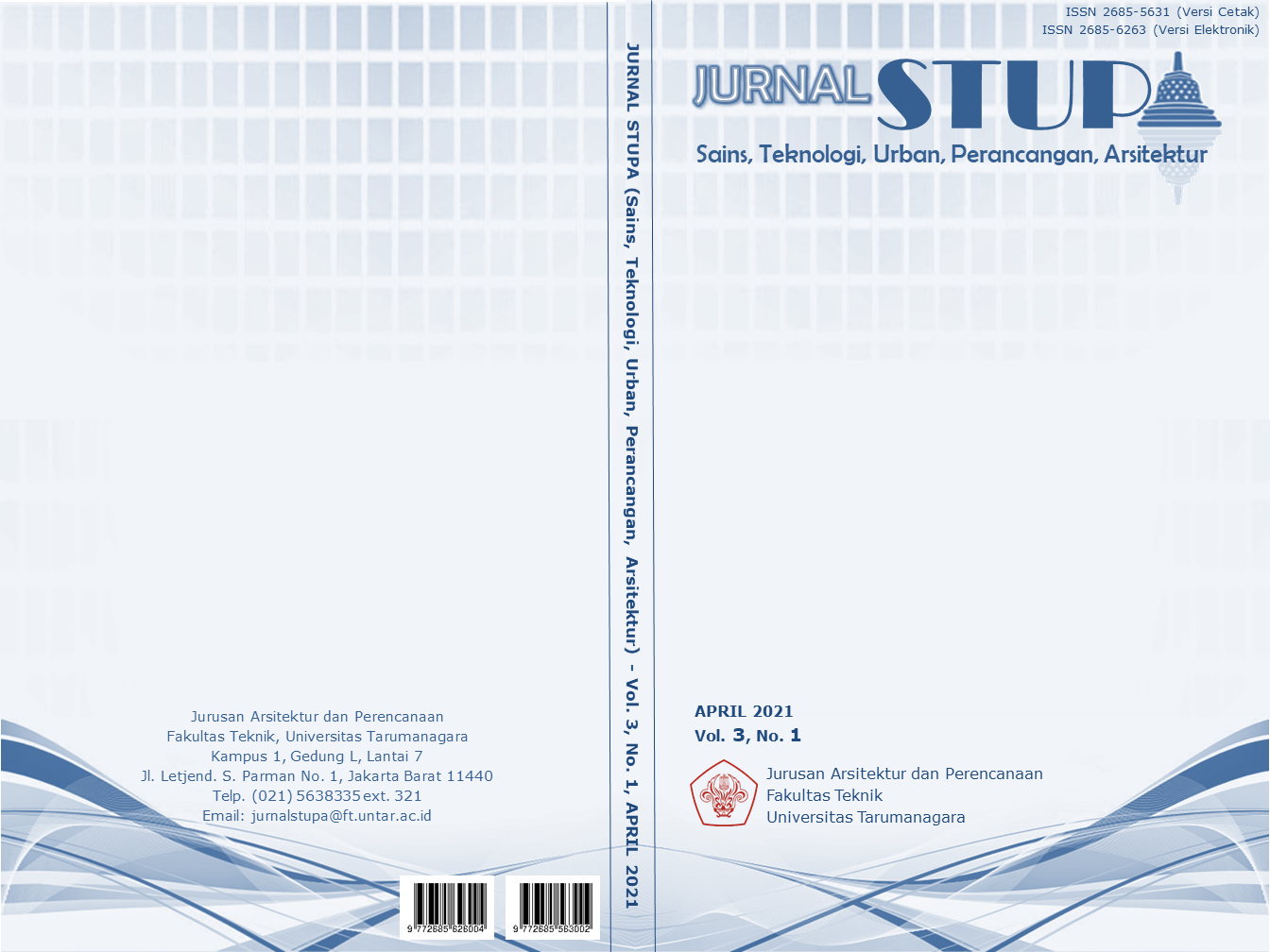PENGHIBURAN DALAM RUANG KESENDIRIAN
Main Article Content
Abstract
In 2020, the Corona Virus is attracting the world's attention. Various fields have been affected by the Covid-19 pandemic, thus affecting the mental health of people who are affected or not. The phenomenon that humans experience in this pandemic is a kind of detachment or removal from reality. Depression, anxiety, aggression, poor self-esteem, stress and decreased sexual arousal, these symptoms are negative mood conditions and this is not good if there is no treatment. The title of the design that will be discussed is Solace in Solitude Space. To improve a low mood requires small changes in one's own life, namely the solitude space. In solitude, people disconnect from the outside and connect to the internal. This mindset seems to spark creativity and inner strength, it helps people get to know themselves better and map their lives in an authentic way. Solitude has the potential as an answer to negative mood states. The method used in this design is cognitive-style and salutogenic approach which translates the Five Senses with Dwelling as a concept in design and produces an area of solitude through the Five Senses. The location was in an area close to the university, namely Daan Mogot Mandiri University, because students had the highest levels of depression and anxiety. The project is located on 2 sites adjacent to the distribution of residential and pavilion functions. Residential as a solitude area with private zoning and pavilions as supporting solitude areas with general zoning.
Keywords: Lima Panca Indra; Negative Mood; Solitude
Abstrak
Pada tahun 2020, Virus Corona menyita perhatian dunia. Berbagai macam bidang terkena dampak oleh pandemi Covid-19, hingga mempengaruhi kesehatan mental masyarakat baik yang terkena atau yang tidak. Fenomena yang dialami manusia pada pandemi ini semacam detachment atau penghapusan dari kenyataan. Kondisi depression, anxiety, aggression, poor self-esteem, stress dan penurunan sexual arousal, gejala-gejala tersebut merupakan kondisi mood negatif (Negative Mood) dan hal ini tidak baik bila tidak ada penanganan. Judul perancangan yang akan dibahas yaitu Penghiburan dalam Ruangan Kesendirian. Untuk meningkatkan suasana hati yang rendah perlu perubahan kecil dalam kehidupan diri yaitu dengan ruang kesendirian. Dalam kesendirian, orang memutuskan koneksi ke luar dan terhubung ke internal. Pola pikir ini tampaknya memicu kreativitas dan kekuatan batin seseorang, hal ini membantu orang mengenal diri sendiri lebih baik dan memetakan kehidupannya dengan cara yang otentik. Kesendirian berpotensi sebagai jawaban pada keadaan mood negatif. Metode yang digunakan dalam perancangan ini adalah cognitive-style dan pendekatan salutogenic yang menerjemahkan Lima Panca Indra dengan Dwelling sebagai konsep pada perancangan dan menghasilkan area kesendirian melalui Lima Panca Indra. Lokasi berada di area dekat dengan universitas, yaitu Universitas Mandiri Daan Mogot, dikarenakan mahasiswa memiliki tingkat depresi dan kecemasan paling tinggi. Proyek terdapat di 2 tapak yang bersebelahan dengan pembagian fungsi hunian dan paviliun. Hunian sebagai tempat area kesendirian dengan zonasi privat dan paviliun sebagai penunjang area kesendirian dengan zonasi umum.
Article Details
References
Bachelard, G. (2014). The Poetics of Space. London: Penguin Books Ltd.
Deci, E L. & Ryan, R., M. (2008). Hedonia, Eudaimonia, and Wellbeing: An Introduction. Journal of Happiness Studies, 9:1–11, DOI 10.1007/s10902-006-9018-1, http://www.preptheday.com/uploads/1/2/0/0/120050120/hedonia_eudaimonia_and_well-being.pdf
Golembiewski, J. A. (2016) Salutogenic Architecture in Healthcare Settings, diunduh 2020, https://www.ncbi.nlm.nih.gov/books/NBK435851/
Heidegger, M. (1971). Poetry, Language, Thought. New York: Harper & Row.
Heidegger, M. (1999). Building, Dwelling, Thinking. In David Farrell Krell (Ed.), Basic Writings Martin Heidegger (pp. 347-363). London: Routledge.
Jormakka, K. (2008). Basic Design Methods. New York: McGraw Hill, Inc.
Lehrer, J. (2011). The Psychology of Architecture. https://www.wired.com/2011/04/the-psychology-of-architecture/
Makhno, S. (2020). Life after coronavirus: how will the pandemic affect our homes. https://www.dezeen.com/2020/03/25/life-after-coronavirus-impact-homes-design-architecture/
Norberg-Schulz, C. (1985). The Concept of Dwelling: On the way to figurative architecture. New York: Rizzoli International Publications, Inc.
Pallasmaa, J. (2012). The Eyes of the Skin : Architecture and the Senses. New York: John Wiley & Sons Inc.
Tanizaki, J. (2006). In Praise of Shadows. London: Vintage Publishing
Zumthor, P. (2010). Thinking Architecture. Basel: Birkhauser



